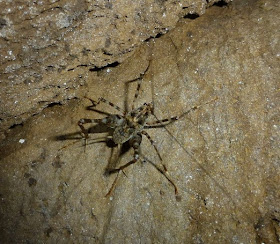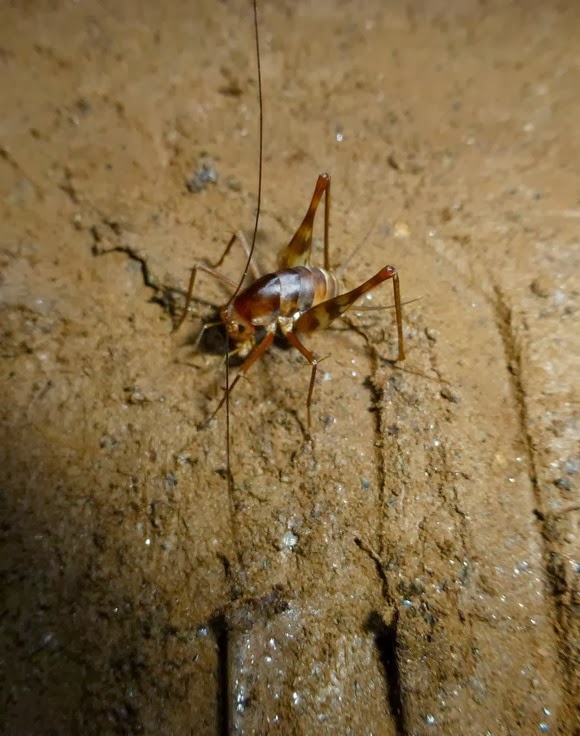We saw very little fauna above ground, just the occasional lizard. There was far more life underground, in the cooler and damper lava tubes. However the tubes are quite warm compared to limestone caves.
There was no water in any of the tubes we visited, though some had damp mud. Many had roots coming in through the ceiling and walls.
There were surprisingly few bats in these lava tubes, though there was evidence that they had been hunted, as there were many wooden poles and nets lying around in various caves.
We saw a variety of invertebrates.
Spiders were always noticeable by their eye shine in our lights. In many caves they were throughout the cave, but in the longest cave they were only seen near the entrance. They are Sparassidae: Heteropodinae (thanks to Peter Jaeger for the ID) -
Web spiders were far fewer in numbers.
I saw 2 types of cricket -
They are probably Rhaphidophoridae , Subfamily Aemodogryllinae .
I only saw a couple of long legged centipedes. They are a different colour from those in Malaysia.
This one was climbing up tree roots -
Whip spiders were particularly common -
One was identified by Michael Seiter as Phrynichus orientalis.
This was a dead one being eaten by millipedes -
And another live one -
There were also whip scorpions (Uropygi) -
Millipedes were only seen in 2 caves.
Jean-Jacques Geoffroy (France) identified them as belonging to the family Cambalopsidae. The genus could be Glyphiulus or Plusioglyphiulus (or even Trachyiulus or Hypocambala).
Cockroaches were only seen in one cave. That cave was close to houses so they could have come from there. They are Periplaneta Americana
There were surprisingly few frog species. These tiny little guys - Micryletta inornata - were cute and quick to hop away from the camera -
This larger one - Polypedates leucomystax - was close to an entrance (thanks to Lee Grismer for frog ID) -
I was looking for scorpions but saw none. The only ones we came across were these large ones found when digging open a cave -
Some mammals use the caves. In several caves I saw rats, with white chests, Niviventer spp. .
I'm think this is one as well -
This might be a rat -
This skull may be a dog
Porcupine also use the caves and the locals put traps at the entrances to catch them. This is a quill -
These droppings could be from porcupine -
A pile of droppings covered in fungus, note the polished rock above the droppings-
Bats were less numerous than expected. All were insect eating bats. As there were signs of the locals trapping them in nets, maybe that accounts for less bats than a year ago when some of the cavers visited (at the same time of the year). Surprisingly the most bats seemed to be in a cave with very bad air. This cave was also particularly warm. And at the entrance we saw quite a few dead bats, Pomona Roundleaf Bat (Hipposideros pomona) -
There are 6 bats flying in this photo -
Surprisingly I only saw 1 gecko in the caves , Cyrtodactylus -
See more on the lava tubes :
Part 1 Gia Ray area
Part 2 Than Phu area
Shapes of lava tubes
© Liz Price
No reproduction without permission

































No comments:
Post a Comment